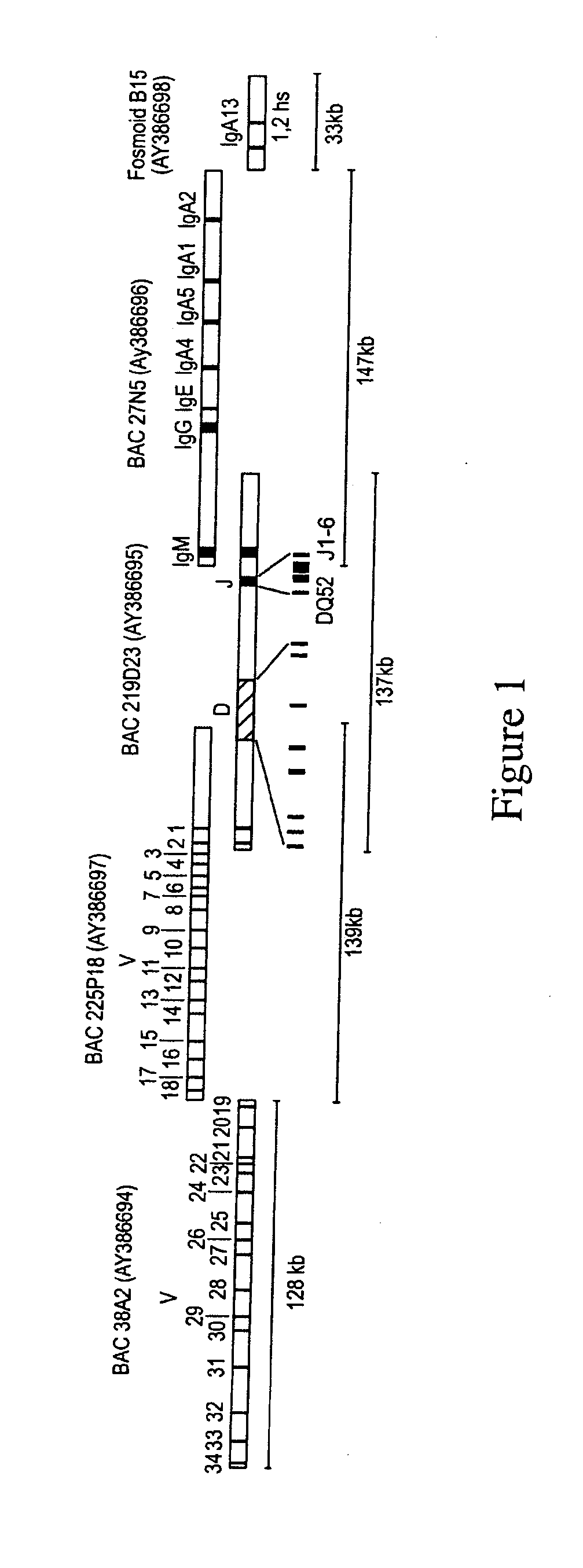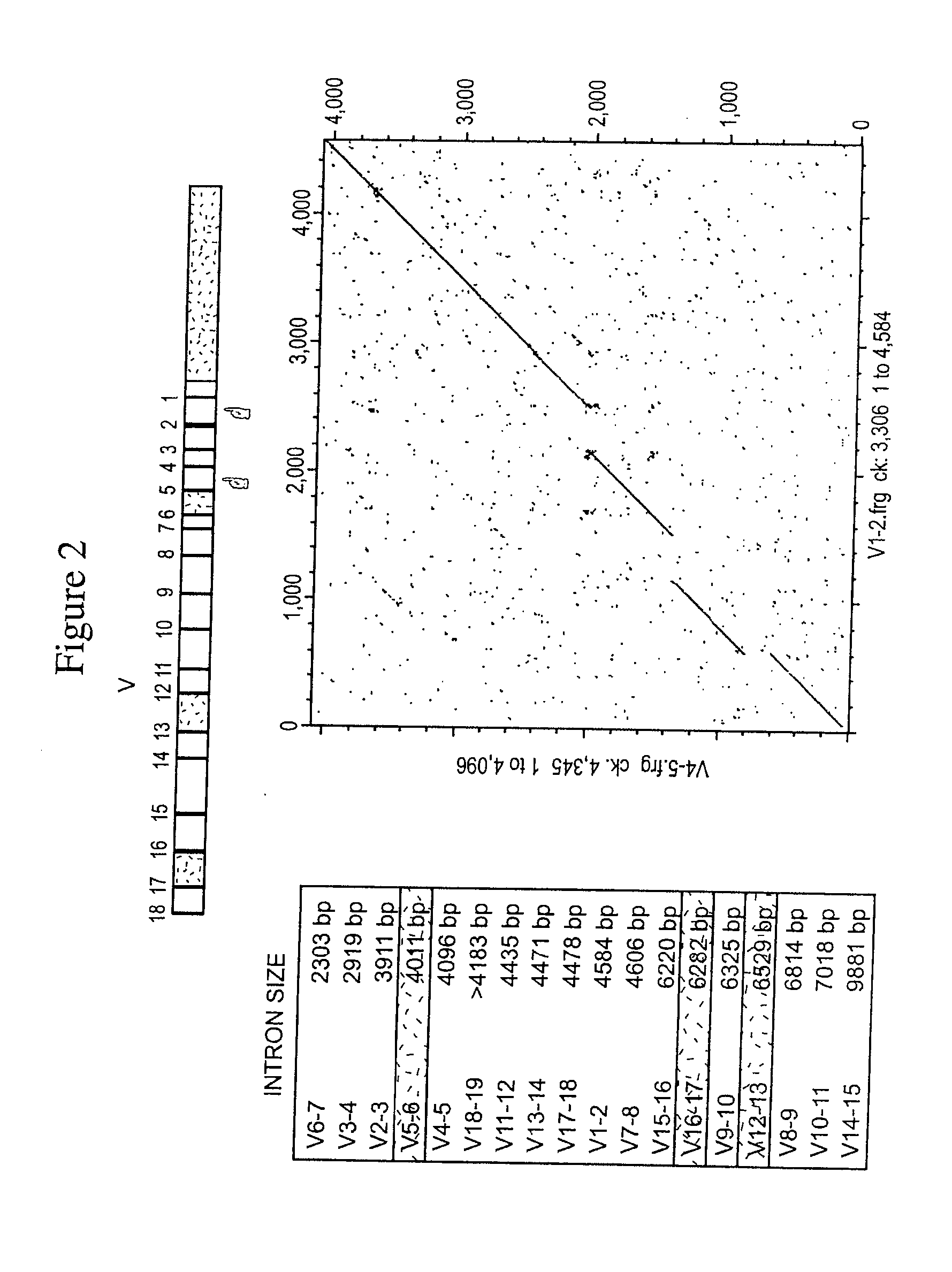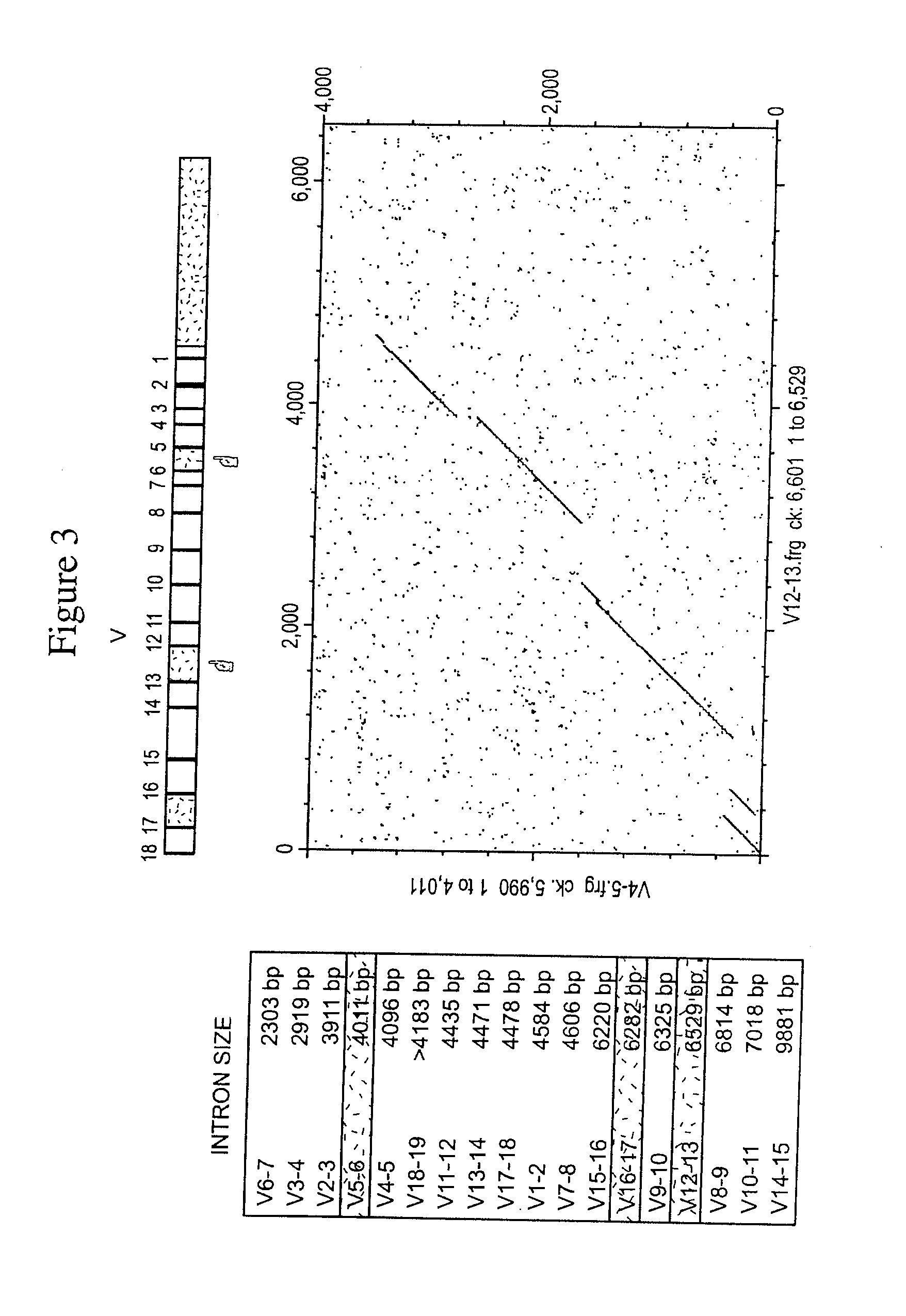Humanized immunoglobulin loci
a human immunoglobulin and locus technology, applied in the field of humanized immunoglobulin loci, can solve the problems of low human immunoglobulin expression, inability to properly regulate the elements present in human immunoglobulin genes in non-human animals, and inability to induce human immunoglobulins in human patients
- Summary
- Abstract
- Description
- Claims
- Application Information
AI Technical Summary
Benefits of technology
Problems solved by technology
Method used
Image
Examples
example 1
Isolation and Sequencing of BAC Clones Containing Rabbit Immunoglobulin Loci
[0133]High molecular weight DNA was isolated from a2b5 male rabbits. The rabbits were euthanized, spleen and kidneys were removed and rinsed in ice-cold PBS. Fat and connecting tissues were removed and processed separately. The organs were cut into pieces and homogenized in a pre-cooled Dounce homogenizer. The supernatant was transferred into cooled 50 ml falcon tubes, mixed with cold PBS and large tissue debris was allowed to sink to the bottom for 2 minutes. Cells in the supernatant were pelleted at 200 g for 10 min at 4° C., washed once with PBS, resuspended in 1 ml PBS and counted. Sets of 5×106, 5×107 and 5×108 cells were embedded in agarose plugs using the CHEF Mammalian Genomic DNA Plug Kit (BIORAD) To optimize conditions for partial digestion with HindIII, plugs were cut into 5 equal pieces and digested with 1 to 10 units of HindIII for various times and temperatures. Best results were obtained with ...
example 2
Construction of a Humanized Rabbit Immunoglobulin Heavy Chain Locus
[0135]BAC and fosmid clones containing rabbit immunoglobulin heavy chain locus sequences were isolated from genomic DNA libraries using probes specific for the constant, variable, and joining gene segments or the 3′ enhancer region. Isolated BACs (FIG. 1) 27N5 (GenBank Acc. No. AY386696), 219D23 (GenBank Acc. No. AY386695), 225P18 (GenBank Acc. No. AY386697), 38A2 (GenBank Acc. No. AY386694) and fosmid Fos15B (GenBank Acc. No. AY3866968) were sequenced (Ros et al., Gene 330, 49-59).
[0136]Selected immunoglobulin coding sequences were exchanged with corresponding human counterparts by homologous recombination in E. Coli by ET cloning (E-Chiang Lee et al., Genomics 73, 56-65 (2001); Daiguan Yu et al., PNAS 97, 5978-5983 (2000); Muyrers et al., Nucleic Acids Research 27, 1555-1557 (1999); Zhang et al., Nature Biotechnology 18, 1314-1317 (2000)).
[0137]Alternatively, DNA fragments were recombined by ligation in vitro and s...
example 3
Construction of a Humanized Immunoglobulin Heavy Chain Locus Using Synthetic Fragments
[0146]Four fragments denoted Unit1, Unit2, Unit3, and Unit 4 (FIG. 13, SEQ ID Nos: 189-192) with human V sequences and rabbit spacers were chemically synthesized. Each fragment was flanked 5′ by an AscI restriction endonuclease recognition sequence, 3′ by a lox71 Cre recombinase recognition sequence followed by Fse I and MluI restriction enzyme recognition sequences. Unit 1 consisted of human VH3-49, VH3-11, VH3-7 and VH3-15 variable genes separated by rabbit spacers I29-30, I3-4, I2-3 and the 3′ half of I1-2 (I1-2B). Unit 2 consisted of human VH3-48, VH3-43 and VH3-64 separated by rabbit spacers I1-2A (5′ half of I1-2), I7-8, I6-7 and the 3′ half of I4-5 (I4-5B). Unit 3 consisted of human VH3-74, VH3-30, and VH3-9 separated by the rabbit spacer sequences I4-5B, I26-27, I11-12 and I17-18.
[0147]Unit 3 had in addition to the afore mentioned upstream flanks an Flp recombinase recognition target (FRT) ...
PUM
| Property | Measurement | Unit |
|---|---|---|
| concentrations | aaaaa | aaaaa |
| concentrations | aaaaa | aaaaa |
| size | aaaaa | aaaaa |
Abstract
Description
Claims
Application Information
 Login to View More
Login to View More - R&D
- Intellectual Property
- Life Sciences
- Materials
- Tech Scout
- Unparalleled Data Quality
- Higher Quality Content
- 60% Fewer Hallucinations
Browse by: Latest US Patents, China's latest patents, Technical Efficacy Thesaurus, Application Domain, Technology Topic, Popular Technical Reports.
© 2025 PatSnap. All rights reserved.Legal|Privacy policy|Modern Slavery Act Transparency Statement|Sitemap|About US| Contact US: help@patsnap.com



